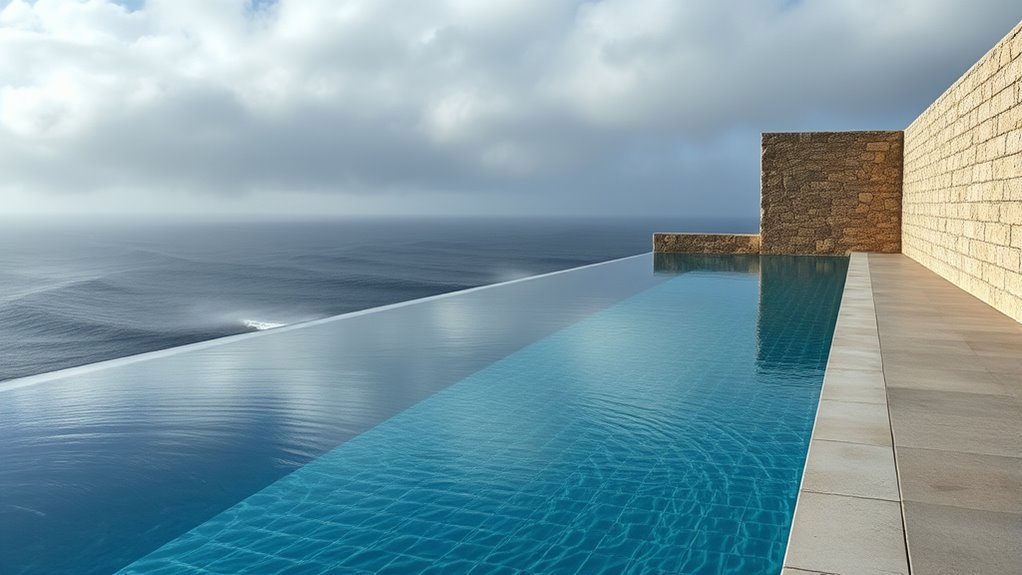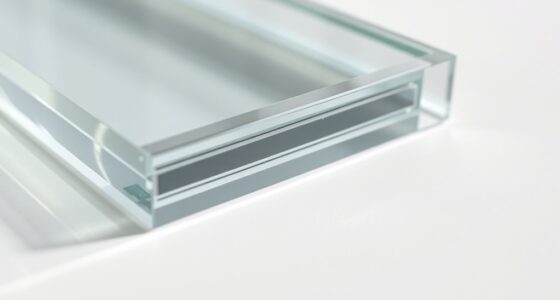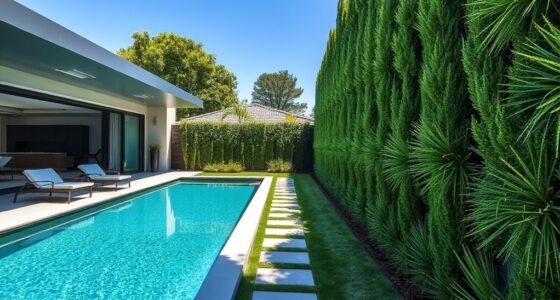To beat gusts and keep your vanishing-edge feature seamless, choose wind-resistant materials like tempered glass or durable acrylic, and position your water feature in sheltered areas. Use natural barriers such as plants or fences and incorporate aerodynamic designs to reduce wind impact. Secure all components with sturdy anchoring and responsive water management systems that adjust to changing conditions. Want to learn more tips to keep your design stunning despite the wind? Keep exploring for expert strategies.
Key Takeaways
- Position vanishing-edge features in sheltered or leeward locations to minimize wind exposure.
- Use aerodynamic edge designs and durable, wind-resistant materials to reduce turbulence and structural stress.
- Incorporate natural or built windbreakers like plants, fences, or walls to shield water surfaces from gusts.
- Install automated water level controls and recirculation systems to maintain stability during gusts.
- Regularly inspect and reinforce edge seals and supports to prevent leaks and damage caused by wind forces.
Selecting Wind-Resistant Materials and Finishes
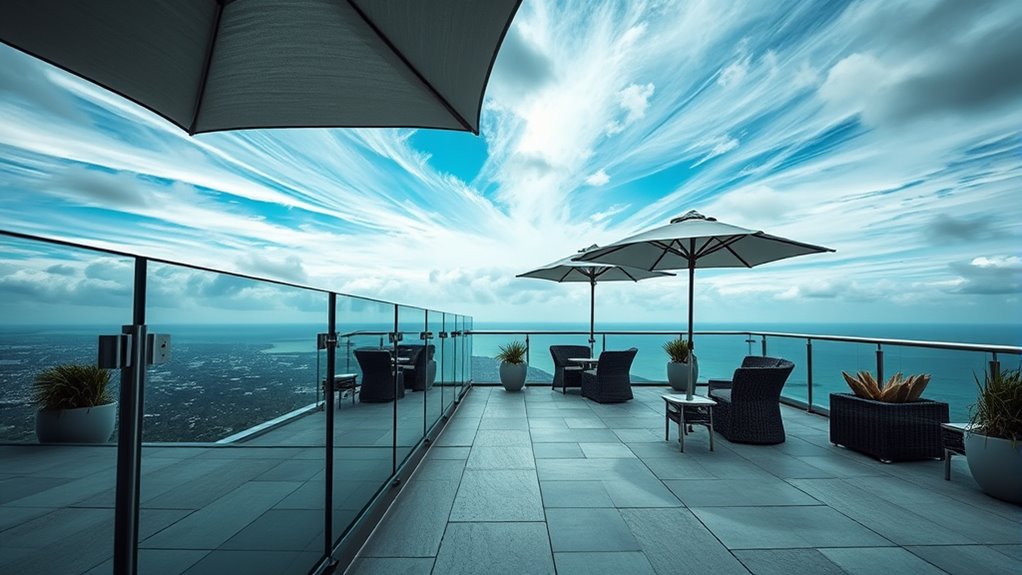
Choosing the right materials and finishes is essential when designing a wind vanishing-edge feature. You need surfaces that can withstand constant exposure to gusts without damage or movement. Opt for durable options like tempered glass, stainless steel, or high-quality acrylic, as they resist cracking and warping. Avoid lightweight or fragile materials that can be easily displaced by strong winds. Finishes should also be resistant to weathering, such as powder-coated or anodized coatings, which prevent corrosion and fading. Selecting textured or matte finishes can help hide fingerprints and water spots, maintaining a clean look. Additionally, understanding the signs of spoilage can help you choose materials that resist mold and discoloration over time. By selecting wind-resistant materials and finishes, you ensure your water feature stays stable, safe, and visually stunning, even in gusty conditions.
Strategic Placement and Orientation of Water Features
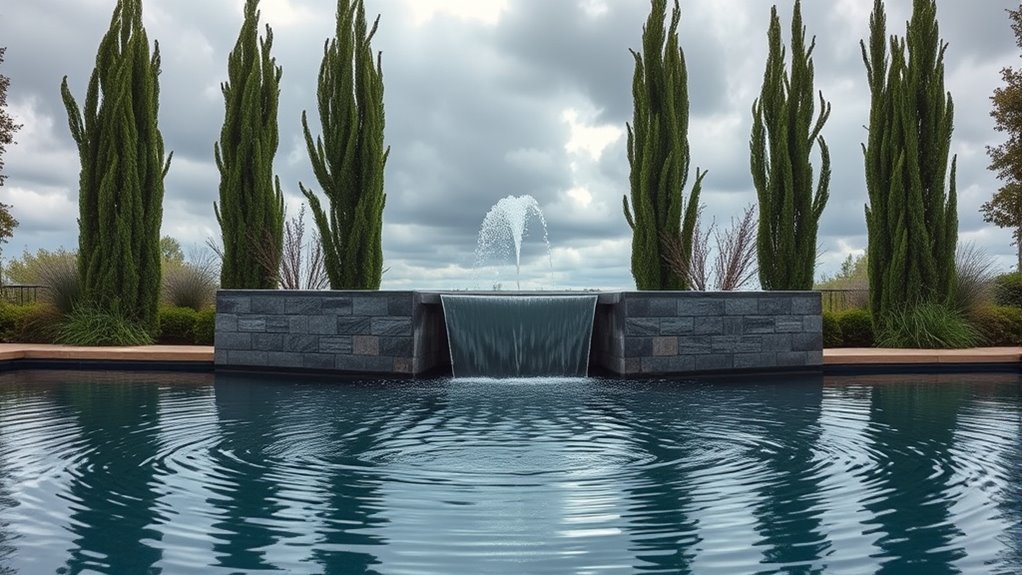
Proper placement and orientation are crucial for guaranteeing your wind vanishing-edge water feature remains functional and visually appealing. Position the feature where natural wind patterns are minimal, such as behind structures or on the leeward side of your yard. Avoid placing it in exposed, open areas where gusts can easily disrupt the water’s flow. Orient the feature so that prevailing winds flow along its length rather than across it, reducing splashing and water loss. Consider the surrounding landscape—placing the water feature near taller plants or structures can help deflect wind. Additionally, positioning the outlet at a lower point can minimize surface agitation caused by gusts. Incorporating Kia Tuning techniques, such as suspension modifications, can also help stabilize the structure against wind-induced movement. Careful placement and orientation ensure your water feature stays serene, maintains its aesthetic appeal, and reduces the need for constant maintenance.
Incorporating Windbreakers and Natural Barriers
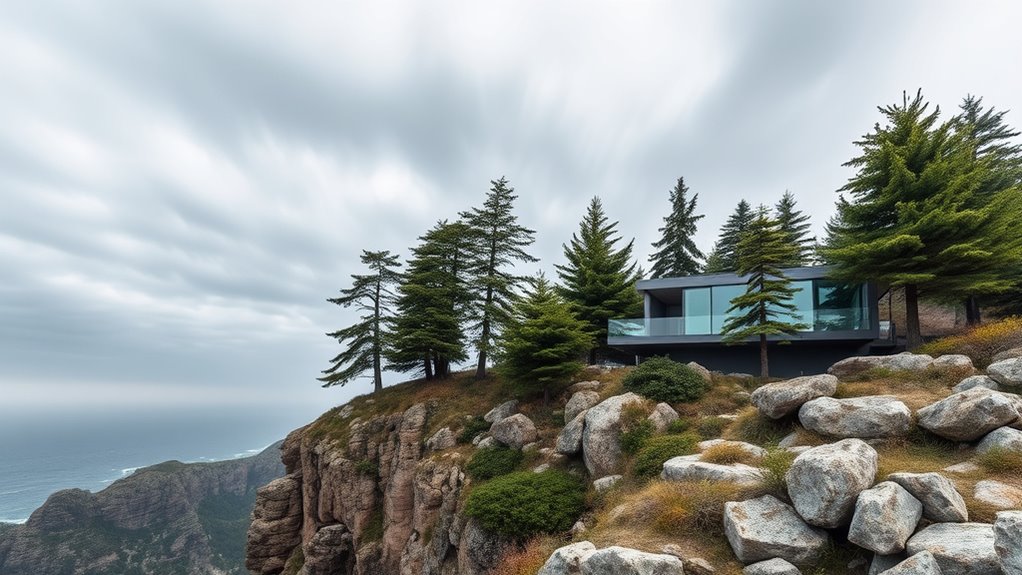
You can reduce wind impact by carefully placing plants that act as natural barriers around your space. Built-in wind barriers, like fences or walls, also help create a more sheltered environment. Combining these strategies offers effective protection against gusts and enhances your design’s overall comfort. Incorporating outdoor planters designed for terrace gardening can further shield your space from strong winds while adding aesthetic appeal.
Strategic Plant Placement
Strategic plant placement plays a crucial role in mitigating wind effects by creating effective windbreakers and natural barriers. You can position shrubs, trees, and tall grasses to slow and redirect gusts away from open areas. Properly placed plants break the wind’s force, reducing its speed before it reaches your living or recreational spaces. Focus on selecting hardy, dense species that thrive locally and grow tall enough to serve as barriers. Planting in clusters or rows enhances their wind-blocking ability, especially when aligned perpendicular to prevailing winds. Additionally, staggered plantings or layered vegetation help absorb and diffuse wind energy more effectively. By thoughtfully arranging your greenery, you create a natural shield that minimizes gust impact and enhances your outdoor comfort. Incorporating native plants ensures better growth and resilience, making your windbreaks more effective over time.
Built-In Wind Barriers
Incorporating built-in wind barriers like windbreakers and natural features offers a powerful way to shield outdoor spaces from gusts. You can use structures such as walls, fences, or screens strategically placed to block prevailing winds. Natural features like dense shrubs, trees, or rocky outcroppings also serve as effective barriers, creating a buffer zone that reduces wind speed. These barriers not only protect your space but also add visual interest. When designing, position them to intercept gusts before they reach seating or dining areas. Combining man-made and natural barriers maximizes wind protection without sacrificing aesthetics. Regular maintenance ensures these barriers remain effective. Understanding wind flow patterns can help in planning optimal barrier placement. By integrating built-in wind barriers thoughtfully, you create a more comfortable, wind-resistant outdoor environment that invites relaxation and enjoyment.
Designing With Safety and Stability in Mind
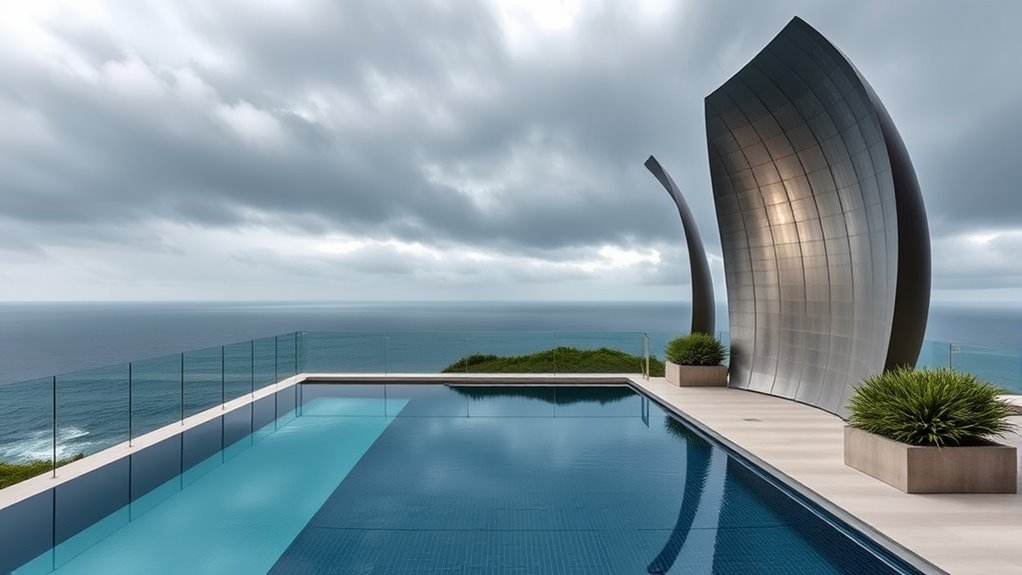
Ensuring safety and stability is vital when designing vanishing-edge wind vanes, especially because these structures are exposed to unpredictable weather conditions. You need to prioritize secure anchoring, balanced weight distribution, and wind-resistant materials. Proper anchoring prevents tipping or shifting during strong gusts, while balanced weight helps maintain the vane’s position under varying wind forces. Selecting durable, weatherproof materials ensures longevity and reduces maintenance risks. Additionally, consider the vane’s shape and size—smaller, streamlined designs tend to handle gusts better. Regular inspections and adjustments are essential to address any wear or displacement over time. Understanding industry trends and incorporating innovative design features can further enhance the vane’s resilience. By focusing on these elements, you create a resilient design that withstands gusts and keeps your installation safe and stable.
Implementing Innovative Water Management Techniques
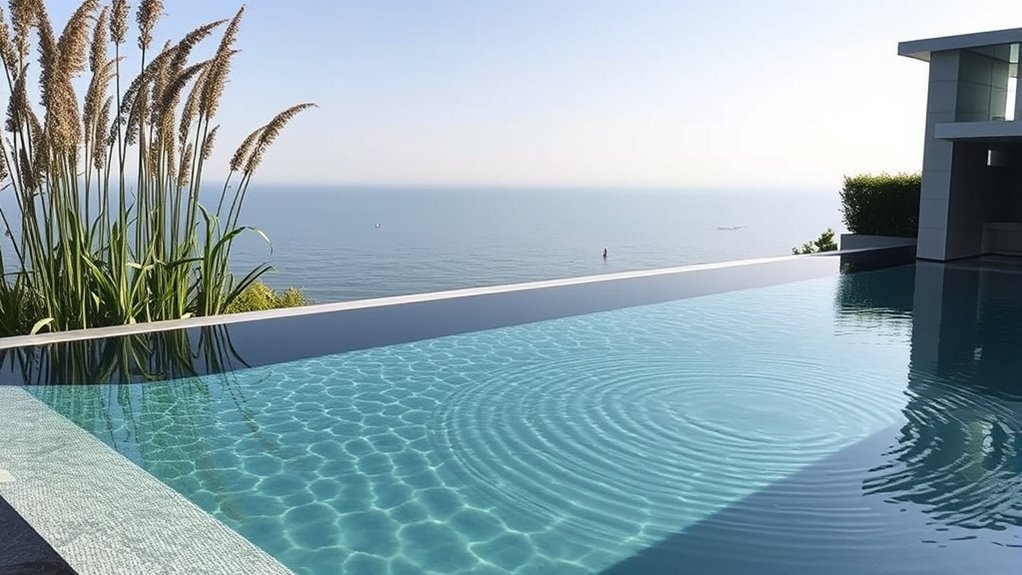
Implementing innovative water management techniques can substantially enhance the efficiency and sustainability of vanishing-edge designs. By incorporating advanced filtration systems, you reduce water loss and prevent debris buildup that can disrupt the edge’s illusion. Using automated water level controls guarantees consistent flow, even during gusty conditions, maintaining the visual effect without manual adjustments. Consider integrating recirculation pumps with variable speed settings to optimize energy use and adapt to changing wind patterns. Additionally, installing sensors that monitor water quality and flow rates helps detect issues early, allowing for swift corrections. These techniques not only improve the aesthetic appeal but also extend the lifespan of your installation. Understanding store hours can help you plan maintenance and service visits during optimal times, ensuring your water management systems operate smoothly. Ultimately, smarter water management helps you create a more resilient, eco-friendly vanishing edge that withstands gusts and environmental challenges.
Maintenance Tips to Minimize Wind-Related Challenges
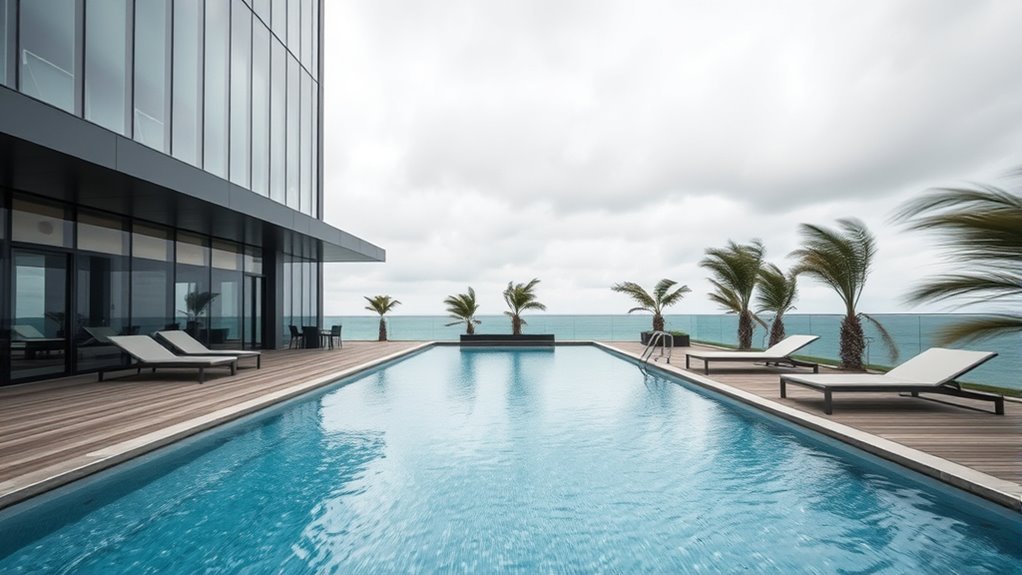
Wind can pose significant challenges to vanishing-edge pools, but regular maintenance can greatly reduce its impact. To keep your pool functioning smoothly, stay vigilant with routine checks and upkeep. Loose debris can block the weir or spillway, so regularly clear leaves and dirt. Inspect the water level to ensure it remains steady, as gusts can cause fluctuations. Tighten or replace any worn seals or fittings to prevent water loss and damage. Additionally, consider installing wind barriers or screens around your pool to reduce gust strength. By staying proactive with these simple maintenance steps, you’ll minimize wind-related issues and preserve the sleek, seamless look of your vanishing-edge design. Understanding the importance of proper maintenance can help in managing these challenges effectively.
Frequently Asked Questions
How Can I Prevent Wind From Disrupting the Aesthetic of My Vanishing-Edge Pool?
To prevent wind from disrupting your vanishing-edge pool’s aesthetic, you can install a glass or acrylic windbreak around the perimeter. Plant tall, dense shrubbery or trees nearby to reduce gusts naturally. Using weighted or secured pool covers during high winds also helps. Additionally, consider adding aerodynamic features like curved edges or wind deflectors to minimize airflow impact, keeping your pool looking pristine and serene regardless of gusts.
What Are the Best Plants to Naturally Shield Water Features From Gusts?
Plant tall, dense evergreen shrubs like arborvitae or cypress around your water feature. These create a natural windbreak, reducing gusts’ impact while blending seamlessly with your landscape. You can also add ornamental grasses or bamboo for a softer barrier. Be sure to plant them close enough to block the wind effectively, but leave space for growth. Regular trimming keeps them healthy and maintains their protective function.
Are There Any Budget-Friendly Solutions for Wind Mitigation in Landscape Design?
Think of your landscape as a ship steering through rough waters—you need to shield it from the gusts to keep it steady. Budget-friendly solutions include planting dense shrubs or using trellises with climbing plants to break the wind. You can also position larger rocks or furniture strategically to act as windbreaks. These simple tricks create a calmer, more resilient outdoor space without breaking the bank.
How Do Wind Patterns Vary by Region and Affect Water Feature Placement?
You should consider regional wind patterns when placing water features. In coastal areas, strong, consistent breezes may require windbreaks or sheltered spots, while inland regions might experience variable gusts. By observing local wind directions and strengths, you can position fountains or ponds where gusts are less likely to disrupt water flow. Adjusting placement based on regional winds guarantees your water features stay calm, attractive, and functional.
Can Smart Technology Help Monitor and Control Wind Impact on Water Features?
Yes, smart technology can definitely help you monitor and control wind impact on water features. You can install sensors that detect wind speed and direction, allowing automated systems to adjust fountain flow or close protective covers in real-time. This proactive approach minimizes splashing and damage, ensuring your water feature stays beautiful and functional despite gusts. With smart tech, you gain better control and peace of mind, even in unpredictable weather conditions.
Conclusion
Think of your vanishing-edge design as a delicate sailboat on a windy day. By choosing wind-resistant materials, smart placement, and natural barriers, you can steer clear of gusts that threaten your oasis. Regular maintenance keeps your landscape steady, just like tending to a boat’s rigging. With these tricks, you’ll create a serene, secure water feature that stands strong against nature’s gusts—transforming your outdoor space into a peaceful retreat, no matter the weather.
